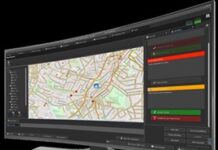
Partnering with BMS providers, or developing proprietary building management systems, will become an important part of access control providers’ product roadmaps over the next five years. “This trend is especially relevant to providers aiming their solutions at the enterprise segment”, says Jim Dearing, senior analyst, security & building technology at IHS Markit.
Recent IHS analysis has found that electronic access control systems are the leading type of security system being integrated into building management system (BMS) platforms. In fact, 29.6 percent of access control equipment shipments — including readers, door controllers and electronic locks — were installed and connected to a BMS platform in 2017.
In addition unit shipments of access control equipment that is connected to a BMS platform are forecast to outpace the rest of the market by a considerable margin, increasing at a compound annual growth rate (CAGR) of 12.5 percent over the next five years. By comparison, total market unit shipments for access control equipment are forecast to rise at a CAGR of 8.8 percent.
Dearing believes that leading access control providers will need to remain vigilant as full command-and-control-style BMS platforms become more popular. Opting to develop a proprietary solution would allow access control providers to protect themselves from this threat. However, outside the top ten access control providers, few companies possess the financial resources and existing product portfolio to compete against the leading BMS market incumbents.
The primary reasons BMS platform integration is becoming more widespread is due to various factors including, interoperability, as BMS platforms are capable of aggregating significant amounts of data from equipment across many domains, which allows end users to manage a wide variety of building management functions via a single platform. As the process is centralised and simplified, it can be completed using fewer resources.
Data visualisation is also playing a part. Accumulated data from multiple domains can be categorised, structured and presented to end users in a series of charts, graphs and other visual tools designed to easily communicate complex information to viewers. As dashboards and data visualisation directly affect a user’s experience with BMS platforms, these tools have also become crucial differentiators for competing products in the market.
The growing trend for analytics means that BMS platforms can offer automated testing, reporting and fault detection and preventative diagnostics functionality to end users. These offerings improve building security by ensuring all devices are working optimally. They also allow end users to compare historical data and recalibrate individual subsystems to improve efficiency. The supplier base is also changing, as many leading security manufacturers are investing heavily in developing their wider building managing portfolios, to ensure their competitive advantages are not eroded by rivals offering more complete solutions.
Access control systems are considered to be an important piece of the smart building puzzle, due to the quality of information the system can provide the BMS platform regarding building occupants’ whereabouts and how they move through the building. BMS platform integration can allow the access control authentication decision to become smarter, by taking into account information from other connected security or building-management systems. A simple example is using video surveillance feeds to verify access-control card swipes.
Access control integration is essential to unlocking the potential of higher-level BMS platform functionality. As more BMS solutions move towards command-and-control-style features, which allow buildings to adjust building management subsystems to respond to individual occupants’ actions, the need for access-control integration grows exponentially. Physical access-control systems and identity-management platforms are the key to initializing many BMS processes, since they provide the starting command that lists the tasks users must accomplish once a specific person has entered the building.
One of the main barriers to adoption are worries over who is actually in charge. In centralised architectures, the BMS platform provider will always want to exert ultimate authority, as the building’s intelligence and its analytics supersede orders from software in access control and other subordinate domains. However, access control suppliers are uncomfortable relinquishing this authority to third-party BMS platforms, because their software feature sets are what enables them to differentiate themselves from their competitors.
Another barrier is the fact that end users can often be slow to adapt to new technologies. During the past decade, the access control industry has struggled to bring security and IT departments together. Smart building integration would likely add a third entity into the mix: facility managers. Due to the slow speed at which large organisations often restructure, getting these three departments to effectively collaborate to leverage the true capability of full building integration is an issue that is unlikely to be resolved in the next five years.











